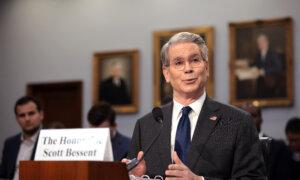The first round of talks went on for more than ten hours.
Negotiators from the United States and China have finished their first round of trade talks in Switzerland and scheduled a second for May 11.
Treasury Secretary Scott Bessent and U.S. Trade Representative Jamieson Greer began meetings in Geneva with a Chinese delegation of high-ranking officials led by Vice Premier He Lifeng.
The two sides convened in an effort to negotiate a way out of their trade war, which has seen tariffs on goods from either nation reach more than 100 percent.
The first round of talks went on for more than ten hours and included a lunch break.
Trade between the two nations, which are also the world’s largest economies, topped more than $660 billion last year, and President Donald Trump suggested he was considering lowering U.S. tariffs on Chinese imports to 80 percent in the coming days.
Hopes for a significant breakthrough appear dim as both sides have struggled to acknowledge who called for the talks to take place, with both publicly saying that the meeting was being held at the request of the other.
Complicating the issue further are geopolitical considerations, such as communist China’s continued efforts to undermine U.S. interests abroad by providing diplomatic, economic, and military assistance to authoritarian powers like Iran, North Korea, and Russia.
To that end, Chinese Communist Party (CCP) General Secretary Xi Jinping was visiting Russian President Vladimir Putin in Moscow over the weekend, casting a shadow over hopes that economic talks could lead to a general thaw in relations between Washington and Beijing.
Treasury Secretary Scott Bessent has said the issue of U.S. trade with China is a key national security issue, and said it should be treated with the corollary seriousness.
“I look forward to productive talks as we work towards rebalancing the international economic system towards better serving the interests of the United States.”
The exact extent of the talks in Geneva has been shrouded in secrecy, with neither side speaking to the press on the way in or out of negotiations.
There are likely to be a few key issues touched upon, however, including the trade deficit, the flow of synthetic opioid precursors out of China, and the CCP’s unfair trade practices, including forced technology transfer and corporate espionage.
Negotiators will also likely be keen to discuss a diverse array of other issues, such as non-tariff trade barriers, anti-dumping practices, intellectual property rights, labor and environmental standards, and rules for dispute resolution.
Many Chinese goods now face a 145 percent tariff rate when exported to the United States, including a punitive 20 percent for China’s role in the fentanyl trade and another 125 percent which the Trump administration has said is meant to address the trade deficit with China, which reached $263 billion last year.
China, meanwhile, has levied its own 125 percent tariff on U.S. imports.
While the U.S. administration has said tariffs on Chinese goods are a way of recouping money lost through unfair trade practices, the levies are paid by American companies importing products from China. As such, tariffs on such a scale amount to a national boycott on many Chinese goods, as American companies are considering other territories to import products from in order to reduce costs.
U.S. container imports from China surged in April as companies raced to avoid paying the tariffs. That trend is expected to reverse unless tariffs are lowered. Some port officials now believe cargo arrivals from China could drop as much as 20 percent in May.
Original News Source Link – Epoch Times
Running For Office? Conservative Campaign Consulting – Election Day Strategies!


